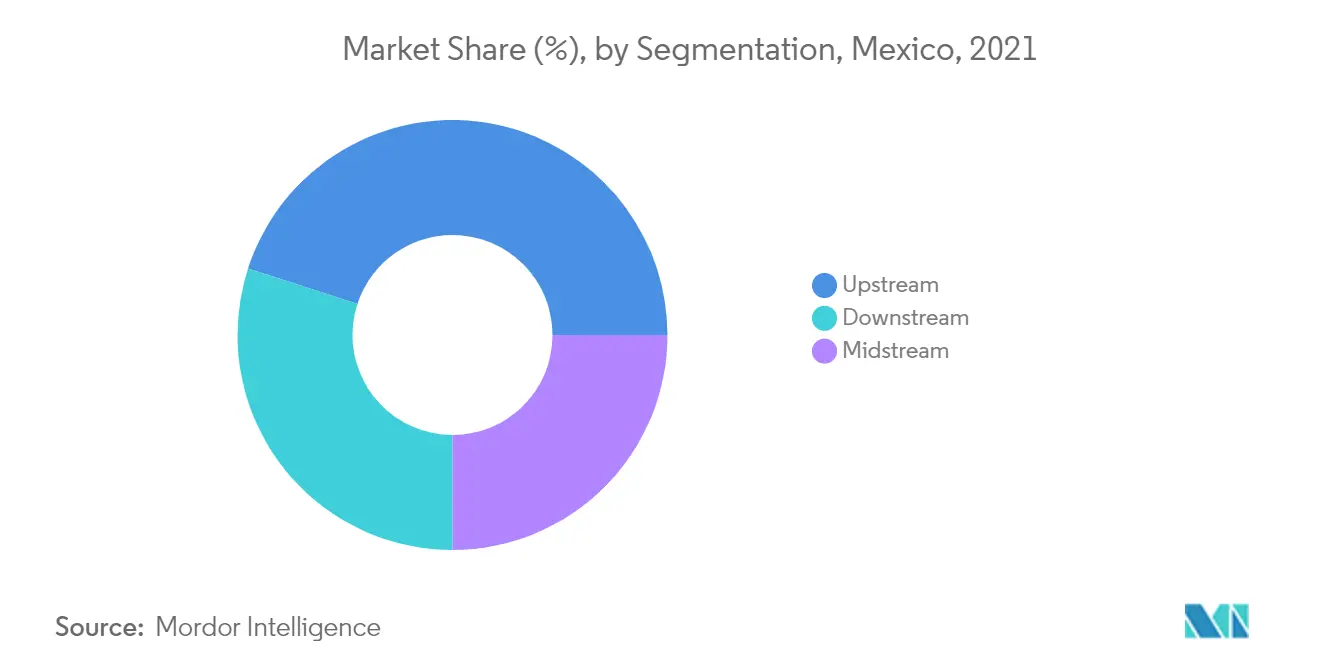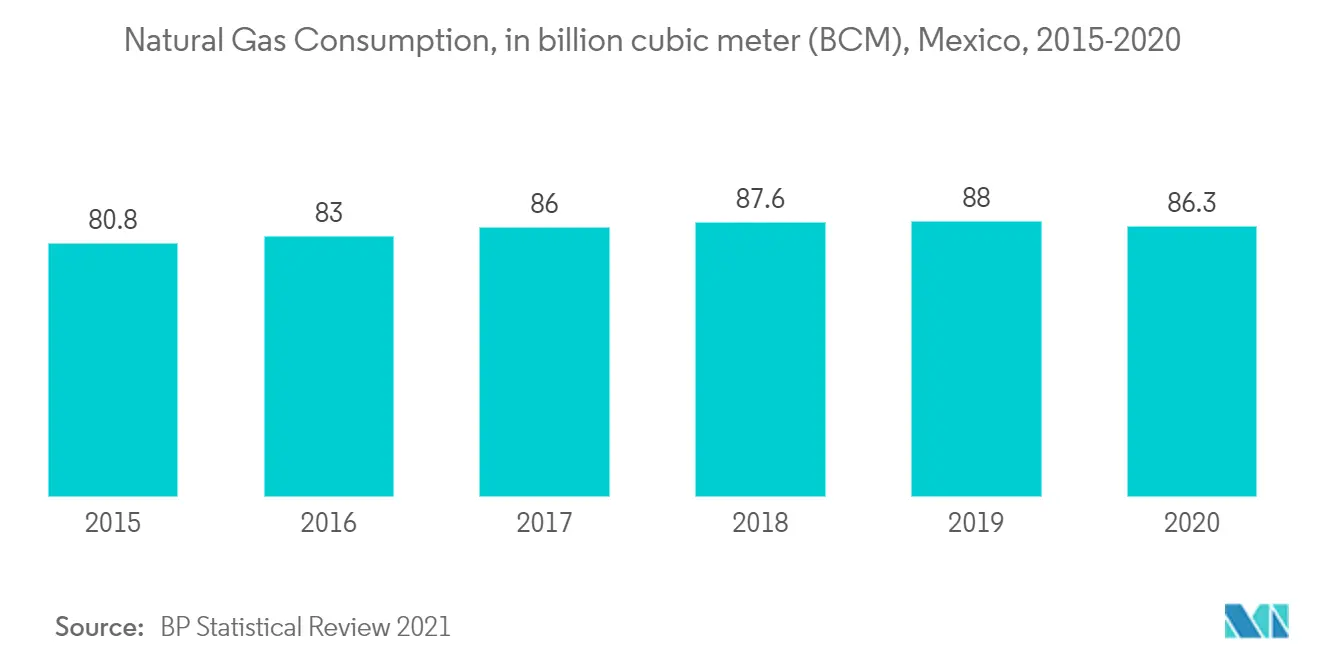Market Trends of Mexico Oil and Gas Industry
This section covers the major market trends shaping the Mexico Oil & Gas Market according to our research experts:
Upstream Segment Expected to Witness Significant Growth
- Mexico has been one of the largest petroleum producers in the world. However, in the past decade, the country witnessed a decline in oil and gas production. The country's proven oil reserves also decreased. In 2020, the country had more than 6 billion barrels of proved crude oil reserves (1P), a 35% decline since 2014.
- The most notable decline in oil production was witnessed in the country's most prolific field Akal (Cantarell). As of 2004, Akal produced 2 million barrels per day (mbpd), and as of 2020, it produced 40,848 barrels per day. However, the field accounts for a large share of gas production in the country, holding a significant market position.
- To address the decline throughout the industry, the former government introduced energy reforms to attract foreign investment in the exploration and development projects, thus ending the 75-year monopoly of PEMEX, a state-owned oil and gas company.
- Since the Energy Reform in 2014, the Mexican oil and gas industry has undergone a profound transformation. Mexico holds a significant number of recoverable resources, including shallow water and deepwater resources, shale resources, and conventional onshore resources. The Energy Reform focused on boosting offshore exploration and producing more crude oil from Mexico's numerous mature offshore and onshore fields, with original oil-in-place (OOIP) of greater than 400 billion barrels.
- Since the reform in 2014, the offshore segment has witnessed significant developments. Recently, in August 2021, Lukoil, a Russian independent oil company, started drilling its first exploration well at Block 12, Gulf of Mexico, by the Valaris 8505 semisubmersible rig. Furthermore, in August 2021, Eni announced an oil discovery in Upper Miocene sequences on the Sayulita Exploration Prospect in Block 10 in the Cuenca Salina Sureste Basin, Offshore Mexico. According to preliminary estimates by the company, this discovery may potentially contain between 150 and 200 Mboe in place. In July 2021, Petronas, a Malaysian national oil company, announced to spud August month's offshore exploration well in Mexico's Block 12, according to its joint venture partner Medco Energi. The Bacalar-1 exploration well was expected to spud in mid-August 2021, and drilling preparations were underway as of July 2021.
- In addition, onshore has witnessed decent developments. In March 2021, Mexico's PEMEX announced that it had discovered over 1.2 billion boe of oil and natural gas in an onshore complex in Tabasco. With this, the company expects to reach gas production levels of 4.287 Bcf/d by 2023.
- Among other exploration and production developments, Mexico also witnessed various investments in the market. For instance, in July 2021, Lukoil agreed to pay USD 435 million and additional unspecified incurred development costs to acquire a 50% operating stake in two Mexican shallow-water blocks from Fieldwood Energy.
- Therefore, owing to these factors, the upstream segment is expected to witness significant growth during the forecast period.

Rising Demand for Natural Gas and LNG is Expected to Drive the Market
- Mexico's domestic natural gas consumption has risen steadily over the last few years. Due to the fall in domestic production, natural gas imports from the United States in the form of LNG have been steadily rising, with the US gas import volumes reaching record highs in June 2021. In 2020, the country consumed 86.3 billion cubic meters (BCM) of gas, which rose by 21.89% from 70.8 BCM in 2011.
- To meet the rising demand for natural gas, state-owned Mexican corporations have decided to invest heavily in developing new natural gas transmission and storage infrastructure. These investments include developing LNG infrastructures, such as regasification and bunkering terminals. These large-scale investments are expected to catalyze the growth of the midstream sector and the Mexican oil and gas sector during the forecast period.
- Due to its geographic location between the Atlantic and the Pacific and its proximity to the vast shale gas reserves in the Southern United States, Mexico has the potential to become an LNG export hub. However, as of August 2021, Sempra's Energia Costa Azul liquefaction project is the only major LNG export terminal under construction in Mexico in Baja California, along the Pacific Coast. In December 2020, TotalEnergies SE acquired a 16.6% stake in phase 1 of the USD 2 billion project, with Sempra LNG and IEnova owning 41.7% each.
- The project will be built in IEnova's existing Energía Costa Azul LNG regasification facility. It will feature a single-train liquefaction facility with a nameplate capacity of 3.25 million ton per annum (MTPA) of LNG. TotalEnergies also signed a 20-year sale and purchase agreement for 1.7 MTPA of LNG from the export facility. Japan's Mitsui signed a similar 20-year deal to buy approximately 0.8 MTPA of LNG from the project.
- Other proposed LNG export projects include the Mexico Pacific Limited's 12.9 MTPA facility at Puerto Libertad in Sonora and Sempra's second project called Vista Pacifico at Topolobampo in Sinaloa. The Mexican government also proposed an LNG export terminal in Salina Cruz on the Pacific Coast.

